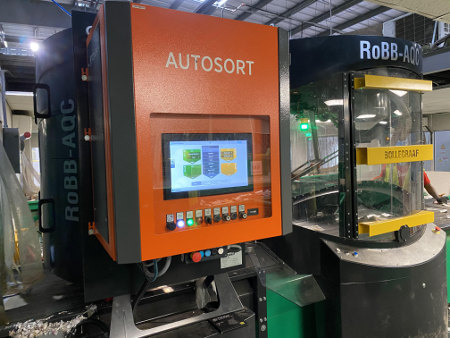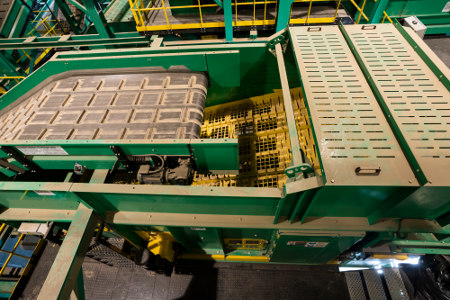 by Mark Neitzey, Director of Sales, Van Dyk Recycling Solutions
by Mark Neitzey, Director of Sales, Van Dyk Recycling Solutions
When talking about recycling plant upgrades, robotic sorting is one of the hottest topics out there. If you’re in the market for new technology such as a robotic sorter, make sure you’re aware of some factors to consider beyond what the machine itself can do for you. The key to a robotic sorter, or any technology, being a successful addition is to properly prepare the material that is fed to that technology.
We travel week in and week out visiting materials recovery facilities all over the U.S. and Canada. We see first-hand the challenges that these sites face: highly contaminated inbound material streams, inbound stream changes (light-weighting, Amazon effect, reduction of ONP, increase of film and trash), high maintenance costs, increasing end product quality demands, maintaining a safe working environment, sorter labor issues (finding willing candidates and getting them to show up every day). Today’s MRF is feeling the brunt of the squeeze!
 A question we often hear is:
A question we often hear is:
- Some days my temp labor service can’t supply me with enough sorters to run at capacity – and the problem is worse on our 2nd shift. Can I just get a few waste sorting robots and not worry about this problem again?
Before investing in a robotic sorting solution, take a look at all parts of your operation. Know that in order for that robotic sorter to fully benefit your operation, you need to ensure that your material is properly sorted, separated and singulated in advance of reaching the robot. Robotic machines on a waste sorting line like to be fed a steady diet of consistent material all on a single layer. If possible, consistent by size with fines removed, similar by shape, rigidity, and density. If the material is piled up, the robotic sorting machine can’t see through the burden depth. If the robot can’t see it, it can’t sort it.
Here are 5 things to consider about your operation before just dropping a robotic sorter into your next retrofit:
1. Is your system excelling at paper/container separation?
Mechanical screens are still an important piece of the puzzle at a MRF to help screen and separate material into different fraction sizes. They size the material into different size fractions and separate 2D material from 3D (paper from containers), sending a target fraction on for further sorting, such as by robotic equipment. If your screen is not spaced properly to separate these materials, or keeps getting clogged by film bags, you will not be feeding your robot that steady diet. In the last few years screens have been greatly improved. Van Dyk and many other suppliers now offer non-wrapping screens that properly size material without allowing film bags to be wrapped around their shafts.
2. Are you stabilizing material on the belt to prevent floating?
The addition of a wind tunnel to an acceleration conveyor is a good way to help process light materials at a higher throughput. Typically, light sheet paper and film starts to fly up and drift when a conveyor speed approaches 550-600 feet per minute. A wind tunnel added to an acceleration conveyor applies air flow at the same speed as the conveyor to stabilize the light floating materials and allow the acceleration conveyor to operate at higher rates of speed (upwards of 800-1000 feet per minute). Recovery rates will rise while accuracy is maintained or even improved. All of this is to continue improving your material separation as it goes down your sorting line, so that when material reaches your robotic sorter it is “pre-sorted” as much as possible. Remember, the better the material is prepared, the better your robot will sort.
3. Do you have a container cleanup device?

An elliptical or ballistic separator (not unlike the elliptical trainer that you might see at your local gym) performs highly accurate separation of 2D and 3D materials. Paddles “walk” 2-dimensional objects over the screen (items like film bags, and light sheet paper). Items with rigidity (bottles, cans, 3D cardboard) bounce backward. Also, the paddles have true 2-inch holes in them to allow the last bit of glass fines to fall through. With minimal maintenance and no star changing required, the elliptical separator is ideal for final cleanup or polishing of the container line. If you plan to have a robot sorting on container QC, make sure you are starting with a clean container fraction headed off to the container sorting line. If you aren’t, that robotic sorter is going to have a tough time wading through an inconsistent stream of waste items.
4. Are your conveyors properly sequenced?
Conveyor belts and sequencing play a large role in the success of any sorting device, including robotic sorters. Why? The goal, again, is to get the material to a single layer to give the robotic separation device a chance to succeed. There are some tactics in regard to conveyor sequencing that can thin out material:
- Place two conveyors in succession and set them at different speeds
- Use wider transfer conveyors directly prior to the robotic sorter
- Use proper cleats on inclining conveyors that help space material and not clump it together
- Whenever possible, feed subsequent conveyors in line instead of at 90-degree angles
- Have all conveyors on variable speed drives to give maximum flexibility to properly sequence the conveyors
These are all small details, but they can be the difference between your robotic sorting solution performing at its best or its worst.
5. Is the material spread out across the width of the belt?
If your system has the extra height needed, a vibratory feeder or a disc spreader could be the perfect tool to help spread the material across a wide belt for single layer coverage to the robotic sorter. If you have a narrower incline conveyor dropping material onto a wider acceleration conveyor, this could be a problem. The material will not get spread across the full width of the acceleration conveyor and the robotic sorter may struggle with clumps of material. A vibratory feeder or disc spreader fans the material as it drops and provides even distribution across the full width of the acceleration conveyor.
WHY VAN DYK?
We know how challenging it is to run your operation. You’re under constant pressure to meet goals in the face of changing end markets. You’re considering a retrofit involving robotic sorting, but don’t know if that particular upgrade will actually get you the results you need.
When you hear talk about the latest robotic sorting solution or optical sorter, remember that an intelligent sorter is only as good as its material feed. It is all about the way it’s fed. You may be in the market for a new robotic sorter, but also consider the possibility that you may not be getting the most out of the equipment that you already have.
If you think your system is not reaching its full sorting potential, give us a call today. We are working on solutions for our customers, and operations like yours, every day. With our help, you can streamline your system, overcome your challenges, and turn them into profit-making opportunities.
Don’t forget, we have a material test center at our headquarter campus that is outfitted with the equipment and principles described in this document. Bring a sample of your plant’s material and test drive our machines before making a commitment. Call to schedule your test today.
We have engineers located in and dedicated to the following regions:
- Northeast
- Midwest
- Mid-Atlantic
- Pacific Northwest
- Pacific Southwest
- Southeast
- Southwest
- Canada
Call us today to reach your local engineer and set up a consultation.
